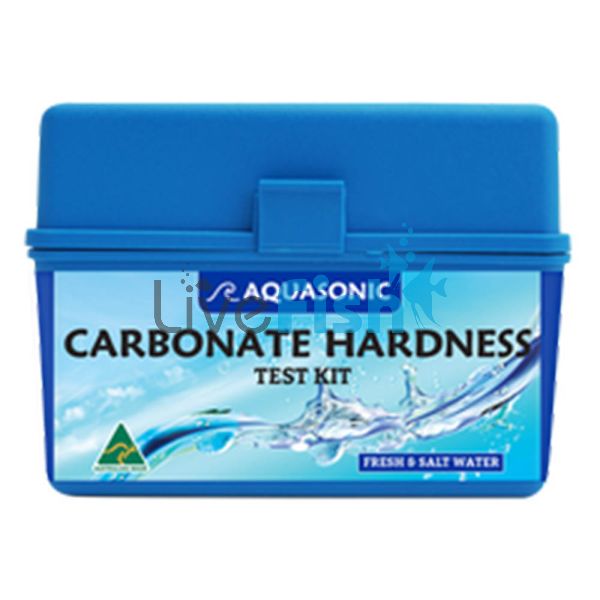Aquasonic Carbonate Hardness (KH) Test Kit
WHAT IS CARBONATE HARDNESS?
The extent of carbonate and bicarbonate contained in a sample of water is the Carbonate Hardness value of that sample. Carbonate Hardness affects all aquaria, both salt and fresh. It is called many names, according to the jargon of the industry or country of origin of the test kit, eg CARBONATE HARDNESS = ALKALINITY = kH (German) = ACID BINDING CAPACITY.
CARBONATE HARDNESS TEST KIT
WHAT IS CARBONATE HARDNESS?
The extent of carbonate and bicarbonate contained in a sample of water is the Carbonate Hardness value of that sample. Carbonate Hardness affects all aquaria, both salt and fresh. It is called many names, according to the jargon of the industry or country of origin of the test kit, eg CARBONATE HARDNESS = ALKALINITY = kH (German) = ACID BINDING CAPACITY.
STABILITY OF pH
The Carbonate Hardness of water is an important measurement because the level of Carbonate Hardness is the basis for the value of the pH in a given sample of water. A strong Carbonate
Hardness reserve in water can mean a very stable pH and the bonus of an alternative supply of carbon dioxide for plants and algae if the supply runs short in an aquarium. This applies equally to marine or freshwater aquaria.
DEPLETION OF THE CARBONATE HARDNESS RESERVE
Acids that form as a result of the breakdown of waste products by bacteria (via biological filtration) are the most common way the carbonate hardness reserve is depleted. In aquariums with little or no carbonate hardness, the pH is very unstable and can drop very quickly to acid. RAISING CARBONATE HARDNESS Aquasonic CARBONATE HARDNESS GENERATOR POWDER is recommended for fresh or salt water applications. 5g will raise the Carbonate Hardness of 100L of water by 20ppm.
CARBONATE HARDNESS CONVERSION TABLE
| Parts per Millions (ppm) CaCO | Multiplier | Unit of Measure |
| 50ppm X | 1 | = Milliequivalents (meq/L) |
| 50ppm X | 2.8 | = German Degrees Carbonate Hardness (DH) |
| 50ppm X | 3.5 | = English Degrees Carbonate Hardness |
DIRECTIONS FOR USE:
The test kit has a dual range, which measures in steps of 10ppm or 20ppm (ppm = parts per million)
TO TEST IN 10ppm STEPS
- Rinse the clean test tube several times in the water to be tested.
- Fill the test tube accurately to the 10mL mark.
- Add 2 drops REAGENT 1 and swirl to mix. A blue colour forms.
- Now add REAGENT 2 a drop at a time and swirl to mix. Keep count of the drops. As the endpoint is reached the test tube colour will change to green. Add 1 more drop to complete the change to yellow. Multiply the number of drops by 10 for the reading in ppm.
TO TEST IN 20ppm STEPS
- Rinse the clean test tube several times in the water to be tested.
- Fill the test tube accurately to the 5mL mark.
- Add 1 drop of REAGENT 1 and swirl to mix. A blue colour forms.
- Add REAGENT 2 a drop at a time and swirl to mix. Keep count of the drops. When the colour changes to yellow the endpoint are reached. Multiply the number of drops by 20 for reading in ppm.
NOTE:
Place the test tube on the white background of the colour chart with the light behind you. The colour in the test tube is best viewed with natural light.
*This colour chart provides a basic guide only. Colours may vary according to various water conditions.
SAFETY DIRECTIONS
KEEP OUT OF REACH OF CHILDREN
WARNING:
Avoid contact with the eyes and skin.
FIRST AID:
- If poisoning occurs, contact a doctor or Poisons Information Centre.
- If swallowed, do NOT induce vomiting. Give a glass of water and seek medical advice.
- If skin contact occurs, remove contaminated clothing and wash the skin thoroughly.
- If in eyes, hold eyes open, flush with water for at least 15 minutes, and seek medical advice.
| Scientific Name | (KH) Test Kit |
|---|




